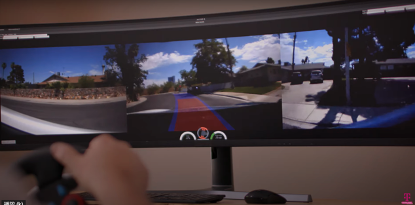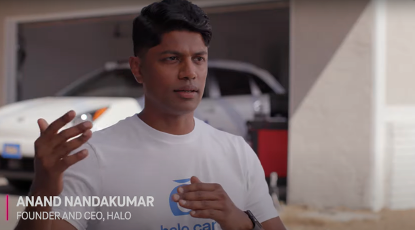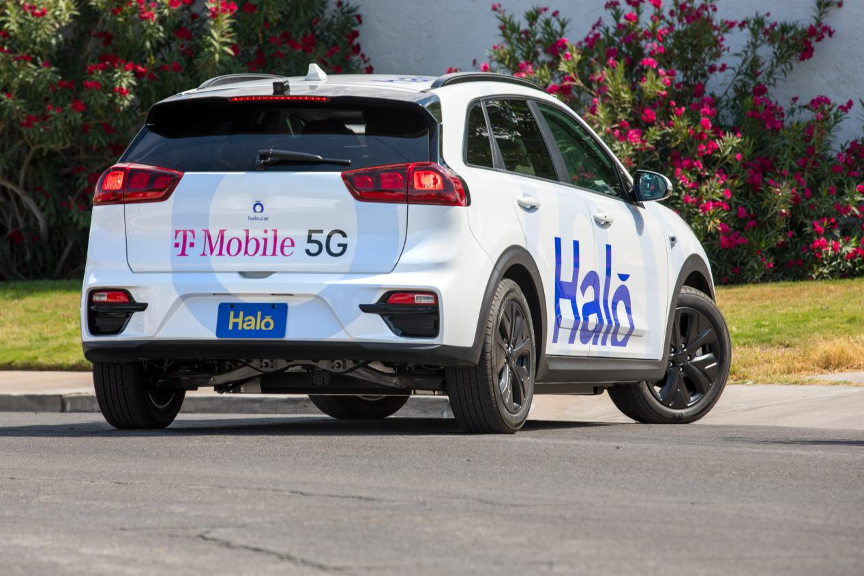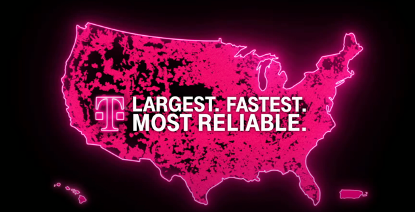Introduction
5G network empowers everything, from communication in remote areas to intelligent connected vehicles! On August 8, Halo, a US-based startup, officially launched its 5G network remote control driving service based on T-Mobile (Editor’s note: the third largest telecommunications operator in the United States) in Las Vegas, USA. Technically speaking, there doesn’t seem to be too many difficulties with Halo’s mode, especially compared to fully autonomous driving. However, from other perspectives, with the steady advancement of 5G networks in China, does Halo’s down-to-earth new mode of autonomous driving have any inspirational significance for us? What insights can it bring to China’s autonomous driving industry?
Technical Details
Halo’s service is both safe and easy to use. Passengers only need to operate the mobile app, and a Halo driverless car will arrive at the pickup location. After the passenger gets in the car, the unmanned vehicle will automatically go to the destination. After arrival, Halo does not need to park, and will move automatically to the next pickup location. Throughout the journey, passengers will not see the driver, who is actually sitting in an office and remotely controls the car through a simulator.
The company expects to start providing formal riding services to customers later this year. It is reported that the service will initially be provided in the urban area of Las Vegas Valley. After full deployment in the city, Halo’s vehicles will have the opportunity to replace the travel needs of thousands of private cars, creating a world with less traffic, less carbon emissions, and blue sky.
Halo uses its self-developed RemotePilot technology to achieve the above functions. This technology requires pre-training of internal drivers to use T-Mobile’s 5G network to remotely operate the car. Drivers can see everything the car sees in real time from their offices and have complete control over the vehicle. Halo has also developed an algorithm for advanced safety parking to ensure that the vehicle can safely stop autonomously in emergency situations or system exceptions.
Using artificial intelligence technology, the vehicle continuously learns the behavior of human drivers in the background, and through a unique feedback loop, trains algorithms in the background. Over time, it will be able to achieve level L3 autonomous driving.
 “To achieve all this, self-driving cars require a high-bandwidth, low-latency, and wide-coverage network, and T-Mobile 5G can provide perfect network services for companies like Halo,” said John Saw, T-Mobile’s chief advanced and emerging technology officer. “There is still a lot of work to be done on the road to fully automated driving, and Halo is taking a unique and intelligent approach to achieving this goal.” T-Mobile CEO Mike Sievert said, “Driving innovation for these kinds of companies is part of why we’re building the nation’s largest, fastest, most reliable 5G network. We’ve launched a 5G network that will change the industry and make our world better. I can’t wait to see what happens next as we work with startups, developers, and entrepreneurs like Halo to build the next 5G-based applications!”
“To achieve all this, self-driving cars require a high-bandwidth, low-latency, and wide-coverage network, and T-Mobile 5G can provide perfect network services for companies like Halo,” said John Saw, T-Mobile’s chief advanced and emerging technology officer. “There is still a lot of work to be done on the road to fully automated driving, and Halo is taking a unique and intelligent approach to achieving this goal.” T-Mobile CEO Mike Sievert said, “Driving innovation for these kinds of companies is part of why we’re building the nation’s largest, fastest, most reliable 5G network. We’ve launched a 5G network that will change the industry and make our world better. I can’t wait to see what happens next as we work with startups, developers, and entrepreneurs like Halo to build the next 5G-based applications!”
Design Intent
“Fully automated driving is a huge challenge in terms of technological and societal acceptance, and cannot be solved in the next few years,” said Anand Nandakumar, Founder and CEO of Halo. “However, Halo’s design goal is to start from a solution that consumers will feel comfortable with today, and gradually increase the degree of automation to meet these challenges.”

Since earlier this year, Halo’s test vehicles have been using T-Mobile’s 5G network to conduct remote control driving tests on public roads in Las Vegas. Halo is currently working with local authorities to meet public transport system needs, accelerate the adoption of electric vehicles (EVs) for self-driving cars, and address traffic congestion and carbon emissions challenges.
Halo

Halo is a early leader in self-driving and autonomous vehicle technology incubated by T-Mobile-sponsored 5G open innovation labs. Founded by executives from companies such as Uber, Cruise Robotics, Proterra and Amazon, Halo will accelerate the use of electric vehicles through an innovative, demand-based car-sharing model, address traffic congestion, and create employment opportunities in the $2.5 trillion global transportation market.
T-Mobile
T-Mobile, based in Bellevue, Washington, is the leader in 5G in the United States, with the largest, fastest, and most reliable 5G network. When the 5G network platform is fully built, it will cover 300 million people in the United States, which is twice the geographic coverage of AT&T and four times that of Verizon. (Editor’s Note: AT&T and Verizon are the largest and second largest telecommunications operators in the United States, respectively). After T-Mobile’s merger with Sprint, the new T-Mobile is expanding its lead and expanding its coverage to more places across the country with faster 5G technology. The ultra-large-capacity 5G technology can provide communication speeds of about 325 Mbps, with a peak communication service of 1 Gbps, and currently covers approximately 150 million people in the United States.
Editor’s Comment
Overall, the RemotePilot technology released by Halo for remote-controlled vehicles does not have too many technical difficulties. Vehicle wire-controlled technology, 5G data communication, and sensor data acquisition technology are relatively mature. Judging from the promotional video released on its official website, the testing environment is also relatively simple, and it does not fully demonstrate its ability to deal with traffic peaks and congestion scenes.
However, before the large-scale commercialization of autonomous driving technology arrives, Halo’s model can still give us some inspiration:
-
From a technological value perspective, Holo can obtain real data of the environment and driver driving behavior very cheaply, and continue to provide training data for the development of autonomous driving technology until it is completely commercialized. In addition, even after full commercialization, unmanned vehicles may still lose control or be in a dilemma in certain specific scenarios, and at this time technicians may still need to remotely intervene to help them out.
-
From a business model perspective, the paid remote driving travel service can effectively recover R&D costs and have strong self-generating ability.
-
From a social perspective, Halo’s model trains the habits of other road traffic participants in advance of the arrival of autonomous driving to prevent others from being too surprised when they see a car automatically steering in a certain direction.China has the world’s largest telecommunications equipment supplier and the leading provider of information and communication technology (ICT) solutions, with global leadership in 5G technology. There are three major telecommunications operators in China with huge numbers of users. Currently, 5G commercial services have been launched in over 50 cities in China. With continuous investment in telecommunications infrastructure, the coverage of 5G technology will be further expanded and the bandwidth and reliability will also be improved. The reliable, low-latency, high-bandwidth, and widely-covered 5G service will arrive in the near future.
In China today, with the heated discussions about “Cars,” “Roads,” and “Clouds,” could the commercialization of Halo be another form of the landing of connected vehicles? Of course, the behavior of having no driver in the cab may involve legal issues, which I am not an expert in. Readers and experts are welcome to leave messages to discuss.
This article is a translation by ChatGPT of a Chinese report from 42HOW. If you have any questions about it, please email bd@42how.com.